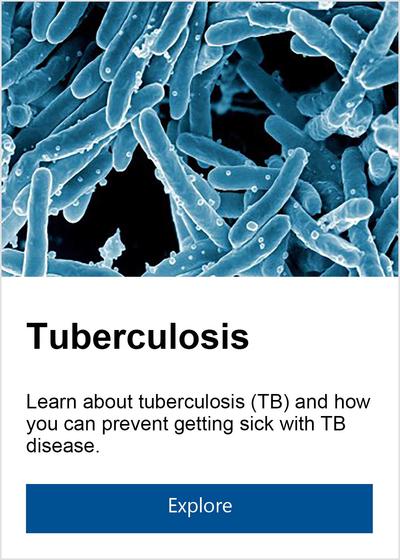Information about tuberculosis (TB)
Tuberculosis (TB) is caused by a bacteria spread through the air when an individual with infectious TB disease coughs, sneezes, or speaks. Transmission occurs when others breathe in the bacteria while in close and prolonged contact with a person with infectious TB disease. If treatment is delayed, TB disease can cause serious illness and death. TB is the second leading infectious killer after COVID. Fortunately, it can be prevented, treated, and cured.
If you have any of the symptoms listed, go see a doctor to find out if you have TB.
Symptoms can include:
- Cough that lasts more than 2 to 3 weeks
- Coughing up blood
- Chest pain
- Fever
- Night sweats
- Weight loss
Testing for TB
To significantly decrease the number of people with TB disease, more individuals with risk factors for TB should be tested and treated. BCG vaccines are given in countries where TB is common. People who have had the BCG vaccine can still get LTBI and TB disease. If you think that your TB skin test might be positive due to a BCG vaccine, you should consider having a TB blood test. The TB blood test is never positive because of the BCG vaccine.
- People who have spent time with someone who has TB disease.
- People from a country where TB disease is common (most countries in Latin America, the Caribbean, Africa, Asia, and Eastern Europe, and Russia).
- Health-care workers who care for patients at increased risk for TB disease.
- Infants, children and adolescents exposed to adults who are at increased risk for latent tuberculosis infection or TB disease.
- People with immunosuppression: HIV infection, organ transplant recipient, treated with TNF-alpha antagonist (for example, infliximab, etanercept, and others), steroids (equivalent of prednisone greater than or equal to 15 mg per day for one month or longer) or other immunosuppressive medication.
If one or more of these situations apply to you, make an appointment with your doctor to get tested and to learn about treatment options. You can also call for an appointment for testing at these local community health centers.
Find a Clinic
Enter your zip code. Choose the nearest clinic from the list. Call to set your next appointment.
Latent TB
Before you become sick with TB disease, there is a period of time when you have no symptoms even though TB bacteria are dormant inside your body. This is called latent TB infection (LTBI). LTBI is not contagious.
When your body can no longer prevent the bacteria from growing, it will multiply and cause TB disease. Individuals with LTBI may become sick with TB disease within weeks to many years after becoming infected. Overall, 5 to 10 percent of people with LTBI develop TB disease over their lifetime; this risk is higher for those with risk factors for progression from LTBI to TB disease, such as undernutrition, HIV infection, and diabetes. Certain behaviors, such as alcohol and smoking, also increase an individual’s risk for developing TB disease.
Treatment
You can take medicine to kill the TB bacteria, so you do not get sick with TB disease. Treatment for latent TB infection can lower your risk of developing TB disease by over 90 percent. Talk with your doctor about treatment for LTBI.
Treatment options include:
- Two medications (Isoniazid and Rifapentine) once a week for 3 months.
- One medication (Rifampin) daily for 4 months.
- Two medications (Isoniazid and Rifampin) daily for 3 months.
- One medication (Isoniazid) daily for 9 months.
TB cases and rates
In 2022, Santa Clara County had the third highest case rate among all California jurisdictions, after Imperial and Alameda counties. TB cases occurred predominantly among Asian and Hispanic populations, with a small percentage in White, African American/African Ancestry, and Native Hawaiian or other Pacific Islander populations. About 96 percent of TB cases occurred among persons born outside the U.S., primarily from the following countries: Vietnam, the Philippines, India, China, and Mexico.
Resources
School mandate and other risk assessments
School mandate information for parents
Prior to school enrollment, children are required to have their healthcare provider complete the Santa Clara County Risk Assessment for School Entry. Take this form to your provider to complete and return to your child’s school. This requirement applies to students attending both public and private schools in Santa Clara County and is based on the authority given to the Santa Clara County Health Officer under the California Health and Safety Code, Section 121515. Effective June 1, 2014, students newly enrolling into school in Santa Clara County are required to undergo TB testing ONLY if their healthcare provider identifies a risk factor for TB exposure.
Additional Forms:
- School Mandate Packet for Parents and Guardians
- Parent Letter (English / Spanish / Chinese / Vietnamese)
TB screening requirements for children in child care
If your child is enrolling in a childcare for the first time, your child will also need a TB risk assessment and, if necessary, a TB test. TB risk assessments and TB tests may be completed when your child receives his/her vaccinations for childcare. If your child’s vaccinations are already up-to-date, you can complete the TB risk assessment and the TB test, if needed, with your child’s health care provider at any time within the first 30 days that your child begins attending childcare in person.
Please see Tuberculosis Screening for Children in Childcare fact sheet for more information.
TB screening requirements for child care/school staff and volunteers
The California Department of Public Health Tuberculosis Risk Assessment for Child Care/School Staff and Volunteers satisfies California Education Code, Sections 49406 and 87408.6 and the California Health and Safety Code, Sections 1597.055 and 121525, 121545, and 121555.
The US Preventive Services Task Force (USPSTF) recommends screening persons at increased risk for LTBI, including those who were born in or lived in countries with increased TB disease prevalence and persons who have lived in high-risk congregate settings (for example, homeless shelters or correctional facilities) in the U.S.
- California Tuberculosis Adult Risk Assessment and User Guide (PDF)
- California Tuberculosis College and University Students Risk Assessment User Guide (PDF)
- California Tuberculosis Pediatric Risk Assessment and User Guide (PDF)
For routine well-child checks, the pediatric TB risk assessment should be used. However, this form does not meet the requirements for students newly enrolling in Santa Clara County schools.
Tuberculosis (TB) Prevention and Control Program
976 Lenzen Avenue
San Jose, CA 95126
United States



